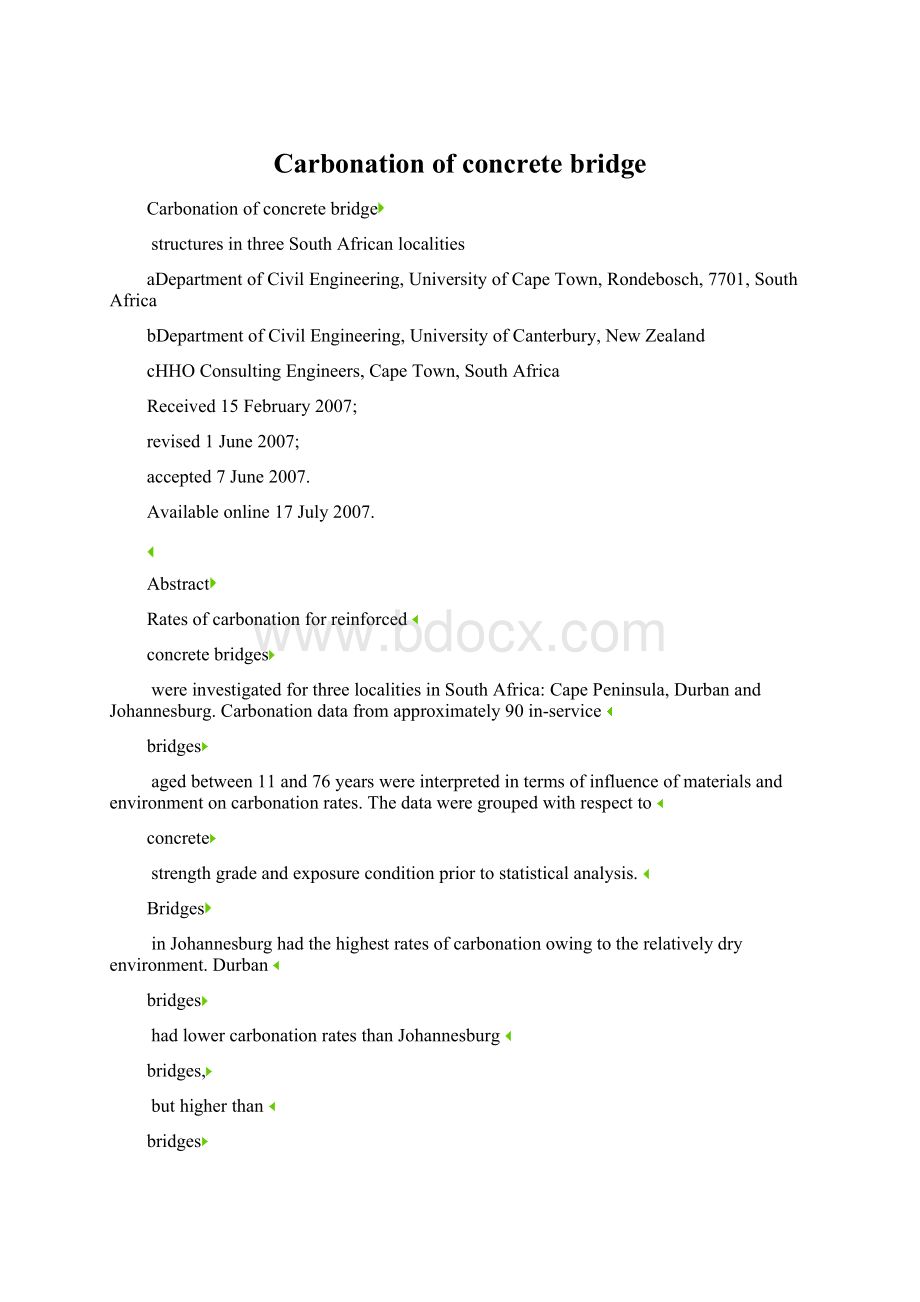 Carbonation of concrete bridge.docx
Carbonation of concrete bridge.docx
- 文档编号:5970950
- 上传时间:2023-01-02
- 格式:DOCX
- 页数:9
- 大小:26.60KB
Carbonation of concrete bridge.docx
《Carbonation of concrete bridge.docx》由会员分享,可在线阅读,更多相关《Carbonation of concrete bridge.docx(9页珍藏版)》请在冰豆网上搜索。

Carbonationofconcretebridge
Carbonationofconcretebridge
structuresinthreeSouthAfricanlocalities
aDepartmentofCivilEngineering,UniversityofCapeTown,Rondebosch,7701,SouthAfrica
bDepartmentofCivilEngineering,UniversityofCanterbury,NewZealand
cHHOConsultingEngineers,CapeTown,SouthAfrica
Received15February2007;
revised1June2007;
accepted7June2007.
Availableonline17July2007.
Abstract
Ratesofcarbonationforreinforced
concretebridges
wereinvestigatedforthreelocalitiesinSouthAfrica:
CapePeninsula,DurbanandJohannesburg.Carbonationdatafromapproximately90in-service
bridges
agedbetween11and76yearswereinterpretedintermsofinfluenceofmaterialsandenvironmentoncarbonationrates.Thedataweregroupedwithrespectto
concrete
strengthgradeandexposureconditionpriortostatisticalanalysis.
Bridges
inJohannesburghadthehighestratesofcarbonationowingtotherelativelydryenvironment.Durban
bridges
hadlowercarbonationratesthanJohannesburg
bridges,
buthigherthan
bridges
intheCapePeninsula,ascribedtodifferencesinambienttemperatureandthenatureofprecipitation.Overall,averagecarbonationratesforGrade30
concretes
overa30-yearperiodvariedfromapproximately0.3 mm/annuminCapePeninsulastructurestoapproximately0.7 mm/annumforJohannesburgstructures.Exposurecondition,characterizedbydegreeofshelter,hadlittleinfluenceoncarbonationrateinDurbanandJohannesburg
bridges,
ascribedtotheaveragerelativehumidityanddurationofprecipitationattheselocalities.Carbonationratesforolder
bridges
werelowerthanfornewerstructures,attributedpossiblytochangesincementcharacteristicswithtimerelatedtotheneedforfasttrackconstructioninmodernstructures.
Keywords:
Carbonation;Carbonationrate;Exposureconditions;
Concretebridges
;Relativehumidity
ArticleOutline
1.Introduction
2.Climaticconditions
3.Analysisofinsitucarbonationdata
3.1.Groupingthedata
3.1.1.Exposureconditions
3.1.2.Concretestrengthgrade
3.2.Statisticalanalysis
3.3.Detectionofgrossoutliers
4.Rateofcarbonation,andpredictionmodels
4.1.Workedexample:
CapePeninsula,exposedgrade40concreteelements
4.2.DurbanandJohannesburglocalities
4.3.Comparisonofcarbonationratesbetweenlocalities
5.Carbonationratesin“OLD”and“NEW”structures
6.Carbonationpredictionfordesign
7.Closure
Acknowledgements
Appendix.Statisticalanalysisexample(ExposedGrade40elements,CapePeninsula)
References
1.Introduction
Carbonationofconcreteisacommonchemicalreactioninwhichatmosphericcarbondioxidereactsmainlywithcalciumhydroxidefromcementhydrationtoformcalciumcarbonateinthepresenceofwater.Thisreactionoccursrapidlyinhighlypermeableconcrete(e.g.concreteofhighwater/cementratiowithinadequatecuringand/orinsufficientcompaction),exposedintherelativehumidityrangebetween50%and75%(theoptimumRHrangeforcarbonation)(ACI[1],Richardson[2]).
CarbonationofconcretereducesthepHoftheporesolutionasitconvertscalciumhydroxidetocalciumcarbonate.Oncethisacidificationprocessadvancestothesteelreinforcement,depassivationofreinforcementoccurs.Thereafter,corrosionofreinforcementmayensueinthepresenceofbothmoistureandoxygen.Eventually,productsofcorrosionwillbeformed,whichmaycausecrackingandspallingofthecoverconcrete.Inevitably,structuralandaestheticaspectsofthestructurearetherebycompromised,leadingtohighrepairandrehabilitationcostsforthesedamagedstructures.
Thispaperreportsastudyoncarbonationofreinforcedconcretebridgesagedbetween11and76years,inthreeSouthAfricanlocalities:
theenvironsofthecoastalcitiesofCapeTown(theCapePeninsula)(30bridges)andDurban(32bridges),andtheinlandcityofJohannesburg(30bridges).Thestudyaroseoutofconcernoverincreasingincidencesofcarbonation-inducedcorrosionofbridgestructuresandthustheneedtoquantifyinsitucarbonationrates.Thepaperprovidesinformationonthemajorclimaticfactorsintheselocalities,givesanalysesofinsitucarbonationdataandcarbonationrates,andcommentsonthelikelyeffectsofchangesincementcharacteristicswithtime.Theanalysesallowedderivationofcarbonationpredictionmodelstoassistindecision-makingformaintenanceofreinforcedconcretestructurestomanagecarbonation-inducedcorrosionriskandassociatedcostsofrepair.Usingtheinformation,coverdepthsfordesignoffuturestructurescanbeassessed,providedimplicationsofanychangesincementcharacteristicsareaccountedfor.
2.Climaticconditions
Climaticconditionsgoverntheexposurerelativehumidity(RH),temperature,andprecipitation(rainfall).Theclimatesforthethreelocalitiesvaryfromcool,wetwintersandhot,drysummersfortheCape,tomildorhotconditionswithhighRHinDurban,tocold,drywintersandhotsummerswithmainlyshortprecipitationperiodsinJohannesburg.CarbonationofconcreteisadiffusionprocessandissensitivetotheinternalRHoftheconcrete.AlthoughinternalRHrelatestotheexternalatmosphericRH,itdoesnotvaryasrapidlyasexternalRH.Thus,theaverageexternalRHfor“wet”and“dry”seasonsforthelocalitieswasused,relatedtotheperiodwithhighandlowrainfall,respectively.Table1showsaveragelocality-specificRHandtemperaturevaluesforthe“wet”and“dry”seasons.
Table1.
AverageRH(basedonmeanhourlyvalues)andtemperatures(basedonaveragedailyvalues)forhighandlowrainfallseasonsforthethreelocalities(S.A.WeatherService[3])
Rainfall
Locality
CapePeninsula
Durban
Johannesburg
Month
Ave.MonthlyRH(%)
Ave.RH(%)
Month
Ave.MonthlyRH(%)
Ave.RH(%)
Month
Ave.MonthlyRH(%)
Ave.RH(%)
High(“wet”)
April
76
78[14]
Oct.
78
79[23]
Nov.
66
68[19]
May
80
Nov.
79
Dec.
68
June
80
Dec.
79
Jan.
69
July
80
Jan.
80
Feb.
70
Aug.
78
Feb.
80
March
68
Sept.
76
March
79
April
64
–
–
April
78
−
−
Low(“dry”)
Oct.
72
71[19]
May
75
73[18]
May
56
51[13]
Nov.
70
June
71
June
52
Dec.
70
July
71
July
49
Jan.
70
Aug.
73
Aug.
46
Feb.
70
Sept.
77
Sept.
46
March
73
–
–
Oct.
57
Full-sizetable
Thevaluesinsquareparenthesesaretheaveragetemperature(°C)forthe“wet”and“dry”seasons.
ViewWithinArticle
Table1suggeststhattheCapePeninsulaandDurbanwouldhaverelativelylowratesofcarbonationduringthewetseasonwiththeirhighaverageseasonalRH,asthesemi-saturatedconcreteporeswouldhinderdiffusionofcarbondioxide.CarbonationwouldbefasterforDurbanthanforCapeTownduringthisseasonduetothedifferenceintheaveragetemperatures.Bycontrast,theJohannesburgareawouldhaveahighrateofcarbonationinbothhighandlowrainfallseasons,theaverageseasonalrelativehumiditiesbeingintherangefortheoptimumRHforcarbonation.Therefore,structuresinJohannesburgshouldhaveahigherrateofcarbonationthansimilarstructuresintheCapePeninsulaandDurban.
Importantly,thenatureofprecipitationinthethreelocalitiesisnotthesame.RelativelyshortrainfalldurationsgenerallyoccurinDurbanandJohannesburg,whilstrainfallperiodsarelongerintheCape,givingdeeperpenetrationofmoistureintotheconcrete.
Table1alsogivesanindicationoftheriskofreinforcementcorrosionafterdepassivation.Richardson[2]statesthattheoptimumconcreteRHforcorrosionisabove80%.Therefore,structuresintheCapePeninsulaandDurbanwilltendtoexperiencecorrosioninthehighrainfallseason,withcarbonationoccurringpredominantlyinthelowrainfallseason.Particularattentionshouldbepaidtothedesignandmonitoringofreinforcedconcretestructuresinthesetwolocalitiessincecarbonation-inducedcorrosionislikelytobeacauseofdeterioration.Incontrast,structuresintheJohannesburgareawillingeneralnotexperiencerapidcorrosionastheaverageseasonalRHiswellbelowthecriticalcorrosionRHofabout80%.Therefore,carbonationofconcretemayberapidinthislocalitybutseriouscorrosionisnotinevitable.However,ifmoisturefromexternalsources(e.g.leakage,ponding)penetratesintothestructuresafterdepassivation,corrosioncouldtakeplace.Also,structureswithverylowcovertosteelmayexperiencecorrosion-induceddamage,sincemoisturecouldpenetratethelimitedcoverlayer.
3.Analysisofinsitucarbonationdata
DatawereobtainedfromRonné[4](CapePeninsula),andfromforensicstudiesconductedforpublicroadsagenciesbyMoore[5](Durbanandadjacentareas;JohannesburgMotorwayandadjacentNationalRoute3(N3)Bridges).ThedataofBallimandLampacher[6](Johannesburg/N3Bridges)werealsoused.Ingeneral,averagecarbonationdepthswereobtainedfrommultiplemeasurementsusingphenolphthaleinsolutionsprayedoncoresorwedgescutfromelementsofthestructures.
Fig.1a–cshowinsitucarbonationdataasafunctionofageofthestructure.Thedataexhibitaremarkablywidescatter,notonlybecauseconcreteitselfisavariablematerial,butalsoduetovariableconstructionfactorsandclimaticconditions.Therefore,thedataweregroupedintermsofexposureconditionsandgradeofconcreteinordertominimisethescatterandgainabetterunderstandingofcarbonationrate.
Full-sizeimage(46K)
Fig.1. Overviewofcarbonationdata(a)CapePeninsula(b)Durbanand(c)Johannesburglocalities.
ViewWi
- 配套讲稿:
如PPT文件的首页显示word图标,表示该PPT已包含配套word讲稿。双击word图标可打开word文档。
- 特殊限制:
部分文档作品中含有的国旗、国徽等图片,仅作为作品整体效果示例展示,禁止商用。设计者仅对作品中独创性部分享有著作权。
- 关 键 词:
- Carbonation of concrete bridge
 冰豆网所有资源均是用户自行上传分享,仅供网友学习交流,未经上传用户书面授权,请勿作他用。
冰豆网所有资源均是用户自行上传分享,仅供网友学习交流,未经上传用户书面授权,请勿作他用。


 铝散热器项目年度预算报告.docx
铝散热器项目年度预算报告.docx
